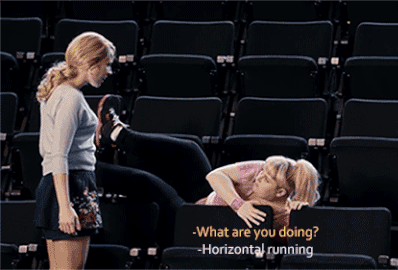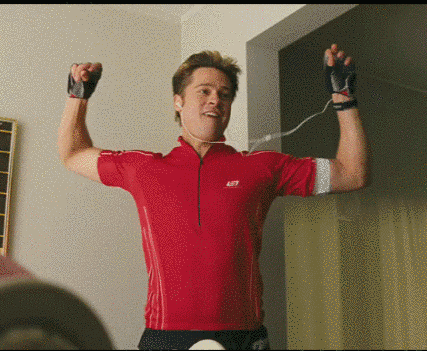
Giphy
When I was in elementary school, we had PE class a couple of times a week. Sometimes we played an organized game of dodgeball, while other times we were allowed to do whatever we wanted as long as we stayed within the fenced-in boundaries of the schoolyard. In middle school, I took a PE class every day for one semester (out of the six semesters that I was at that school). To pass the class, girls had to be able to do one unassisted pull-up. I can’t do a pull-up to this day but somehow managed to make a passable effort when I was in sixth grade. I didn’t have to take PE again until high school, and even then, I was only required to take it every other day for one semester. The next semester we were required to take health. After my freshman year, there was no fitness requirement. I elected to take modern dance as an elective anyway.
I stayed pretty active, though it was no longer a requirement. I played both indoor and outdoor field hockey in eighth grade. I joined the freshman soccer team in ninth grade. I played on recreational soccer teams organized by the YMCA for probably a decade. Even when I stopped playing sports, I would take a long walk after school each day with a friend of mine who lived in the neighborhood or play badminton in the backyard. On days when I didn’t get at least a mild form of exercise, I had trouble sleeping. When I started college, I was required to complete four trimesters of physical education classes or join a sports team. These classes weren’t graded, but they were required to graduate. I took modern dance (again), step aerobics, yoga, and joined the softball team for a year.

Pitch Perfect / Giphy
According to the Centers for Disease Control and Prevention, children need 60 minutes of physical activity daily. Adults should aim for at least 150 minutes of aerobic exercise weekly. Both children and adults should perform a variety of activities. Muscle-strengthening exercise (weight lifting, yoga, resistance training, etc.) should be undertaken at least two days a week for adults and three days a week for children. For my entire childhood, from elementary school through high school graduation, my schools failed to ensure that I was getting enough exercise. And, since attending school took up a solid eight hours every day, I didn’t have the ability or time to exercise for an hour after getting home. My routine, for the most part, was get home, do homework, eat dinner, watch a show, go to bed. Rinse and repeat.
I can assure you that I was not the only student who wasn’t getting enough exercise. Primary and secondary curriculums have not changed enough since the mid-90s for today’s young people to be getting the recommended amount of exercise either. Recess and PE requirements in school, from elementary through college, are a start, but if local schools don’t force students to exercise daily by making changes to their curriculum, and many don’t, then students and their parents need to take physical activity into their own hands.
From 2011 to 2014, 12.7 million children (aged 2–19) in the United States were obese. This doesn’t take into account the number of children who were simply overweight. Obesity is linked to diet, exercise, and sometimes, chronic or genetic conditions. Like adults, children who eat high-calorie, low-nutrient foods and who lead a mainly sedentary lifestyle (sitting at school all day and then choosing to play video games or watch television instead of taking a walk or playing basketball, for instance) are more likely to become overweight, and if their bad habits continue, obese. Unfortunately, obese children are likely to carry their obesity with them into adulthood, which can lead to a host of physical and psychological ailments.
The good news is this: obesity isn’t a lifelong sentence. Even if you were inactive during childhood, which probably wasn’t your fault, you can make lifestyle changes for your health. Students don’t have to do all 60 minutes of their physical activity in one fell swoop. In fact, doing ten minutes here and ten minutes there is perfectly acceptable (jumping jacks and crunches in between subsequent television episodes, for instance). Taking a small step, like signing up for a beginner’s pilates class that’s offered at the college gym two nights a week, would knock out the minimum strengthening exercises suggested by the CDC.

Burn After Reading / Giphy
Here are a few other benefits of regular exercise as stated by the Mayo Clinic:
- Weight loss or management, which may have the side effect of improved self-esteem
- Disease prevention
- Release of endorphins to enhance mood
- Boost in energy
- Sleep improvement
As a college student, you may feel like you never have enough time to get all your work done, let alone get to the gym for an hour every other day. The truth is, though, that the benefits of getting regular exercise outweigh the time that it will cost you. When you’re sleeping better and feeling happier and more energetic, you won’t have to spend so much time convincing yourself to start a paper or losing an entire morning because you decided to sleep in. If you know that self-motivation isn’t going to be enough to get you to the gym, sign up for a class or, even better, sign up for a class that you have to pay for. I’ve found that the prospect of losing money by not going to something I’ve already spent money on is quite motivating.
If you’re in middle or high school, you’ll probably have more time but less independence. You can’t just go to the campus gym whenever you feel like it because there isn’t one. Instead, join a sports team (the YMCA offers numerous leagues for kids across the country), take up running (always let someone know where you are), or play kickball with some neighbors. There are plenty of options for you to stay active, and the benefits of physical exercise are the same no matter your age.
Personally, I got a Fitbit. It’s not a high-end one, but it vibrates on my wrist if I’ve been stagnant for too long, and the feeling that a bracelet can be judgemental is enough to make me pace around the house until I’ve hit my step goal. You can also watch your sleep patterns change over time and begin to understand how exercise affects the rest of your life. Apple, Garmin, Withings, and Misfit also offer wearable fitness trackers that you can use to keep track of your steps, exercise, and sleep. Regardless of whether your school is mandating physical activity, you always have the ability to take your physical health into your own hands.
-
A Survival Guide for Students Who Have to Work on Black Friday
-
The Health Risks of Hookah and E-Cigarettes
-
How to Avoid Burnout in All Areas of Your Life
-
Seven Benefits of Attending Alateen Meetings
-
The Truth: Why You Should Get Fit to Finish the School Year
-
How to Recognize Cyberbullying
-
Why You Should Make an Effort to Drink More Water
-
What Exactly Is Maturity and How Do You Develop It?
-
Why You Should Get a Flu Shot Now
-
How to Prevent Illness and Cope with Being Sick at College
-
Should You Take a Leave of Absence?
-
The Truth about Caffeine

